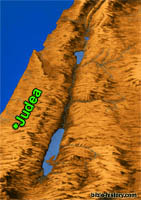Abilene
H1 on the Map
 Region. The territory of Abilene was a Roman district that extended over the slope of the anti-Lebanon, which was north of Mount Hermon. It was given the name after its capital city, Abila, which is situated in a gorge by the river Abanah (modern Barada), to the northwest of Damascus.
Region. The territory of Abilene was a Roman district that extended over the slope of the anti-Lebanon, which was north of Mount Hermon. It was given the name after its capital city, Abila, which is situated in a gorge by the river Abanah (modern Barada), to the northwest of Damascus.
Augustus assigned Abilene to Herod the Great, and after his death in four B.C. it was added to the province of Syria. By the time of the Emperor Tiberias (A.D. 14-37) it was in the Tetrarchy of
Lysanias.
Lk 3:1
Smith's Bible Dictionary
Abilene: (land of meadows), Lu 3:1 a city situated on the eastern slope of Antilibanus, in a district fertilized by the river Barada (Abana). The city was 18 miles from Damascus, and stood in a remarkable gorge called Suk Wady Barada.
Smith's Bible Dictionary (Abilene)
International Standard Bible Encyclopedia - ABILENE
ABILENE
a-bi-le'-ne (Abeilene, Codex Alexandrinus and Codex Vaticanus; Abilene, Codex
Sinaiticus): Mentioned in
Lu 3:1
as the tetrarchy of Lysanias at the time when John the Baptist began his
ministry. The district derived its name from Abila, its chief town, which was
situated, according to the Itinerarium Antonini, 18 Roman miles from Damascus on
the way to Heliopolis (Baalbec). This places it in the neighborhood of the
village of Suk Wady Barada (see ABANAH), near which there are considerable
ancient remains, with an inscription in Greek stating that a "freedman of
Lysanias the tetrarch" made wall and built a temple, and another in Latin
recording the repair of the road "at the expense of the Abilenians."
The memory of the ancient name probably survives in the Moslem legend which
places the tomb of Abel in a neighboring height where there are ruins of a
temple. Josephus calls this Abila, he Lusaniou, literally, "the Abilene of
Lysanius," thus distinguishing it from other towns of the same name, and as
late as the time of Ptolemy (circa 170 AD) the name of Lysanias was associated
with it.
The territory of Abilene was part of the Iturean Kingdom, which was broken up
when its king, Lysanias, was put to death by M. Antonius, circa 35 BC. The
circumstances in which Abilene became distinct tetrarchy are altogether obscure,
and nothing further is known of the tetrarch Lysanias (Ant., XIX, v, 1; XX, ii,
1). In 37 AD the tetrarchy, along with other territories, was granted to Agrippa
I, after whose death in 44 AD it was administered by procurators until 53 AD,
when Claudius conferred it again, along with neighboring territories, upon
Agrippa II. On Agrippa's death, toward the close of the 1st century, his kingdom
was incorporated in the province of Syria. See LYSANIAS.
C. H. Thomson
International Standard Bible Encyclopedia - ABILENE
Read The Bible
- 1599 Geneva Bible (GNV)
- 21st Century King James Version (KJ21)
- American Standard Version (ASV)
- Amplified Bible (AMP)
- Amplified Bible, Classic Edition (AMPC)
- Authorized (King James) Version (AKJV)
- BRG Bible (BRG)
- Christian Standard Bible (CSB)
- Common English Bible (CEB)
- Complete Jewish Bible (CJB)
- Contemporary English Version (CEV)
- Darby Translation (DARBY)
- Disciples’ Literal New Testament (DLNT)
- Douay-Rheims 1899 American Edition (DRA)
- Easy-to-Read Version (ERV)
- English Standard Version (ESV)
- English Standard Version Anglicised (ESVUK)
- Evangelical Heritage Version (EHV)
- Expanded Bible (EXB)
- GOD’S WORD Translation (GW)
- Good News Translation (GNT)
- Holman Christian Standard Bible (HCSB)
- International Children’s Bible (ICB)
- International Standard Version (ISV)
- J.B. Phillips New Testament (PHILLIPS)
- Jubilee Bible 2000 (JUB)
- King James Version (KJV)
- Lexham English Bible (LEB)
- Living Bible (TLB)
- Modern English Version (MEV)
- Mounce Reverse Interlinear New Testament (MOUNCE)
- Names of God Bible (NOG)
- New American Bible (Revised Edition) (NABRE)
- New American Standard Bible (NASB)
- New American Standard Bible 1995 (NASB1995)
- New Catholic Bible (NCB)
- New Century Version (NCV)
- New English Translation (NET)
- New International Reader's Version (NIRV)
- New International Version - UK (NIVUK)
- New International Version (NIV)
- New King James Version (NKJV)
- New Life Version (NLV)
- New Living Translation (NLT)
- New Matthew Bible (NMB)
- New Revised Standard Version (NRSV)
- New Revised Standard Version Catholic Edition (NRSVCE)
- New Revised Standard Version, Anglicised (NRSVA)
- New Revised Standard Version, Anglicised Catholic Edition (NRSVACE)
- New Testament for Everyone (NTE)
- Orthodox Jewish Bible (OJB)
- Revised Geneva Translation (RGT)
- Revised Standard Version (RSV)
- Revised Standard Version Catholic Edition (RSVCE)
- The Message (MSG)
- The Voice (VOICE)
- Tree of Life Version (TLV)
- World English Bible (WEB)
- Worldwide English (New Testament) (WE)
- Wycliffe Bible (WYC)
- Young's Literal Translation (YLT)
Table of Contents
Main Menu
- Ancient Assyrian Social Structure
- Ancient Babylonia
- Ancient Canaan During the Time of Joshua
- Ancient History Timeline
- Ancient Oil Lamps
- Antonia Fortress
- Archaeology of Ancient Assyria
- Assyria and Bible Prophecy
- Augustus Caesar
- Background Bible Study
- Bible
- Biblical Geography
- Fallen Empires - Archaeological Discoveries and the Bible
- First Century Jerusalem
- Glossary of Latin Words
- Herod Agrippa I
- Herod Antipas
- Herod the Great
- Herod's Temple
- High Priest's in New Testament Times
- Jewish Literature in New Testament Times
- Library collection
- Map of David's Kingdom
- Map of the Divided Kingdom - Israel and Judah
- Map of the Ministry of Jesus
- Matthew Henry Bible Commentary
- Messianic Prophecy
- Nero Caesar Emperor
- Online Bible Maps
- Paul's First Missionary Journey
- Paul's Second Missionary Journey
- Paul's Third Missionary Journey
- Pontius Pilate
- Questions About the Ancient World
- Tabernacle of Ancient Israel
- Tax Collectors in New Testament Times
- The Babylonian Captivity
- The Black Obelisk of Shalmaneser
- The Books of the New Testament
- The Court of the Gentiles
- The Court of the Women in the Temple
- The Destruction of Israel
- The Fall of Judah with Map
- The History Of Rome
- The Incredible Bible
- The Jewish Calendar in Ancient Hebrew History
- The Life of Jesus in Chronological Order
- The Life of Jesus in Harmony
- The Names of God
- The New Testament
- The Old Testament
- The Passion of the Christ
- The Pharisees
- The Sacred Year of Israel in New Testament Times
- The Samaritans
- The Scribes
Ancient Questions
- Why Do the Huldah Gates Appear Different in Ancient Replicas and Modern Photos?
- What Is the Origin of the Japanese and Chinese Peoples? A Biblical Perspective
- How did the ancient Greeks and Romans practice medicine and treat illnesses?
- What were the major contributions of ancient Babylon to mathematics and astronomy?
- How did the ancient Persians create and administer their vast empire?
- What were the cultural and artistic achievements of ancient India, particularly during the Gupta Empire?
- How did ancient civilizations like the Incas and Aztecs build their remarkable cities and structures?
- What were the major trade routes and trading practices of the ancient world?
- What was the role of slavery in ancient societies like Rome and Greece?
- How did the ancient Mayans develop their sophisticated calendar system?
Bible Study Questions
- Why Do Christians Celebrate Christmas?
- How Many Chapters Are There in the Bible?
- The Five Key Visions in the New Testament
- The 400-Year Prophecy: Unpacking Genesis 15 and the Journey of a People
- The Authorized (King James) Version (AKJV): Historical Significance, Translation Methodology, and Lasting Impact
- Exploring the English Standard Version (ESV): Its Aspects, Comparisons, Impact on Biblical Studies, and Church Use
- A Detailed Historical Analysis of Language Updates in the KJ21: Comparison with Other Versions
- A Detailed Historical Analysis of the American Standard Version (ASV): Comparison to the King James Version, Influence on Later Translations, and Evaluation of Strengths and Weaknesses
- A Detailed Historical Analysis of Amplifications in the Amplified Bible (AMP) and Its Comparison to Other Bible Translations
- Detailed Historical Analysis of the Amplified Bible Classic Edition (AMPC): Examples of Amplifications and Comparative Analysis with Other Bible Translations
About
Welcome to Free Bible: Unearthing the Past, Illuminating the Present! Step into a world where ancient history and biblical narratives intertwine, inviting you to explore the rich tapestry of human civilization.
Discover the captivating stories of forgotten empires, delve into the customs and cultures of our ancestors, and witness the remarkable findings unearthed by dedicated archaeologists.
Immerse yourself in a treasure trove of knowledge, where the past comes alive and illuminates our understanding of the present.
Join us on this extraordinary journey through time, where curiosity is rewarded and ancient mysteries await your exploration.
Recent posts
-

The Role of AI in Cryptocurrency Trading and Blockchain Security
Artificial Intelligence (AI) is rapidly reworking industries, and the cryptocurrency sector is not any exception. From enhancing trading techniques to... -

The impact of IP address on LinkedIn traffic
IP address has a serious impact on LinkedIn traffic. Before you start working with the site, you should clarify the specifics of this influence and ho... -

The Bible in Museums: Where to See Ancient Scripture Today
The Bible, as one of the most influential books in human history, has shaped not only religious beliefs but also the course of civilization. Its stori... -

How AI is Revolutionizing 2025: Latest Innovations and Industry Applications
Artificial Intelligence (AI) has turn out to be one of the maximum transformative technologies of the twenty first century. As we flow via 2025, AI ke... -

AI-Powered Innovation: How Businesses Are Leveraging AI for Growth
Artificial Intelligence (AI) is no longer a futuristic concept however a fundamental driving force of innovation in these days’s commercial enterpri...